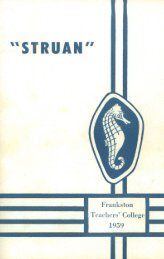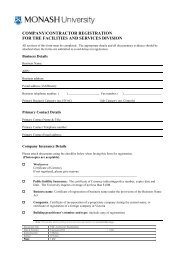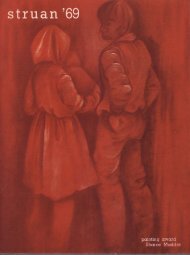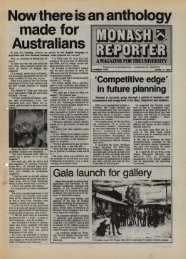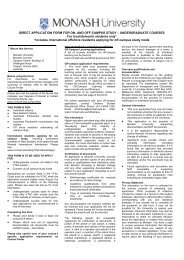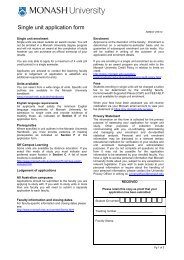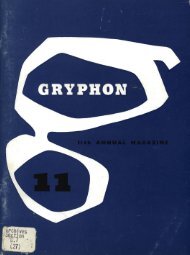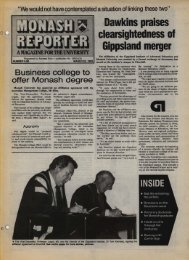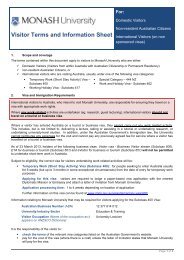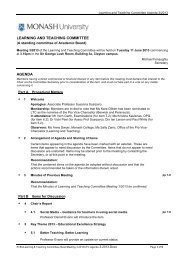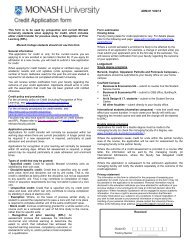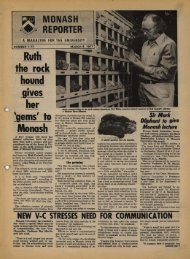Gone (down) but not forgotten - Administration, Monash University
Gone (down) but not forgotten - Administration, Monash University
Gone (down) but not forgotten - Administration, Monash University
Create successful ePaper yourself
Turn your PDF publications into a flip-book with our unique Google optimized e-Paper software.
GREAT STAIRWAYS<br />
OF THE WORLD<br />
• This month's stairway no doubt has a purpose, even if it is <strong>not</strong><br />
immediately obvious to the viewer. Its exact location tends to be a<br />
secret, <strong>but</strong> enthusiasts can track it <strong>down</strong> in the eastern end of the<br />
Education building. Photos - Tony Miller.<br />
Water clocks dampen<br />
hot air enthusiasts<br />
The 'organisers of a recent international hydraulics conference turned to<br />
<strong>Monash</strong> engineer, Dr Deane Blackman, to provide them with the<br />
appropriate technology for pulling speakers into line - water clocks.<br />
The clocks, which timed the speakers<br />
o ....er intervals from three to 40 minutes,<br />
at the 21st Congress of the International<br />
Association of Hydraulic Research, proved<br />
a polite and effective means of<br />
policing the line between interest and<br />
boredom.<br />
Dr Blackman, senior lecturer in<br />
Mechanical Engineering and an expert<br />
in the field of fluid dynamics, said his<br />
interest in ancient technology - and<br />
particularly, things Roman - was well<br />
known.<br />
(Water clocks were used to time the<br />
speeches of barristers in the Roman<br />
courts.)<br />
The five clocks he designed consisted<br />
of a black cone-shape with a solid bOltom<br />
and open ·top.<br />
The cone was attached to a central<br />
brass rod, the top of which carried a<br />
decorative horse and to the bottom of<br />
which weights could be screwed.<br />
In use, the cone was floated on water<br />
in a perspex cylinder. Water entered a<br />
small hole in its base at a rate determined<br />
by the size of the weight.<br />
When a speaker's time had elapsed,<br />
water reached the top of the cone and the<br />
whole contraption sank <strong>down</strong> the<br />
cylinder, giving a whole new meaning to<br />
the term "going <strong>down</strong> the tube" .<br />
"The response was very favorable.<br />
They worked quite well.<br />
"Over 40 minutes they were accurate<br />
to within about 30 seconds and over<br />
three minutes to within about 10<br />
seconds," Dr Blackman said.<br />
<strong>Gone</strong> (<strong>down</strong>) <strong>but</strong> <strong>not</strong> <strong>forgotten</strong><br />
The gallant vessel, Sir John <strong>Monash</strong>.<br />
lies in five metres of water in the shadow<br />
of the <strong>Monash</strong> bridge.<br />
Having acquitted itself nobly in battle,<br />
the magnificent craf( was shamelessly<br />
pirated and sunk by angry rivals.<br />
(ts captain, Rob Trebilco, and the<br />
crew went <strong>down</strong> with honor, saluting all<br />
the way.<br />
Fortunately such infamy had splendid<br />
outcome, for it was only fitting that<br />
<strong>Monash</strong> <strong>University</strong>'s entry in the grand<br />
Concrete Canoe Race should find its<br />
resting place in a hallowed spot by the<br />
Anderson Street bridge, built across the<br />
Yarra by <strong>Monash</strong> and Anderson,<br />
consulting engineers, in 1899. (The<br />
human victims re-surfaced).<br />
The vessel, with its 7mm shell strengthened<br />
by a new silicone fume admixture<br />
(which reduces the number of voids in<br />
the concrete), was constructed as part of<br />
a fourth year program in concrete technology<br />
by Civil Engineering students.<br />
The second <strong>Monash</strong> <strong>University</strong> entry<br />
(the previous one was four years ago) in<br />
the annual race, it fought successfully<br />
through [he heats before losing out to<br />
twO boats in the final.<br />
Both were mostly fibreglass, for the<br />
competition rules allow for construction<br />
using concrete and any additives, in<br />
unspecified quantities.<br />
Supervisor, Dr Peter Darvall, Reader<br />
in Civil Engineering, says towards the<br />
end the riverside crowd was chanting for<br />
Sir John, <strong>but</strong> "it was beaten by unfortunate<br />
wind and current".<br />
However. he claimed moral victory,<br />
for having "the only genuine concrete<br />
MONASH REPORTER<br />
boat on the river"; the closest rival, the<br />
Royal Melbourne Institute of Technology<br />
entry, having snapped in half<br />
while being unloaded from its trailer.<br />
"We had boating parties from the colleges<br />
hassling us all the way; Chisholm<br />
organised the race and Chisholm won,"<br />
he says.<br />
seven in the race) that they sent one as a<br />
rammer - <strong>but</strong> it couldn't catch us in the<br />
heats.<br />
"We're highly encouraged by the<br />
results and the next stage will be to go<br />
into higher technology for the canoe<br />
shape."<br />
(Sydney <strong>University</strong> used origami prin<br />
for the First International Concrete<br />
Canoe Race in Stockholm earlier this<br />
yeaL)<br />
Dr Darvall said teams of students<br />
would attempt the salvage of the Sir<br />
John <strong>Monash</strong>, which would be mounted<br />
for display on the east side of the department's<br />
laboratories, next to the<br />
"It had so many boats (four of the ciples to construct a six metre canoe from the W''''!!a''<br />
• Dr Peter Darvall, right. sentor tutor, Mr Rafael Grzebieta, second from right, and fourth year Civil Engineering students display the Sir<br />
John <strong>Monash</strong> before its fateful involvement in the grand Concrete Canoe Race. The vessel's vital statistics are: length 4m, width .7m, shell<br />
thick:-.ess, 7mm, and weight 4O-SO kg.<br />
20 NOVEMBER 13. 1985<br />
Printed by Waverley Otlset Publishing Group. (03) 560 5111 . Typ&Sel by BP Typesetting Ply. lid.• (03) 561 2111



